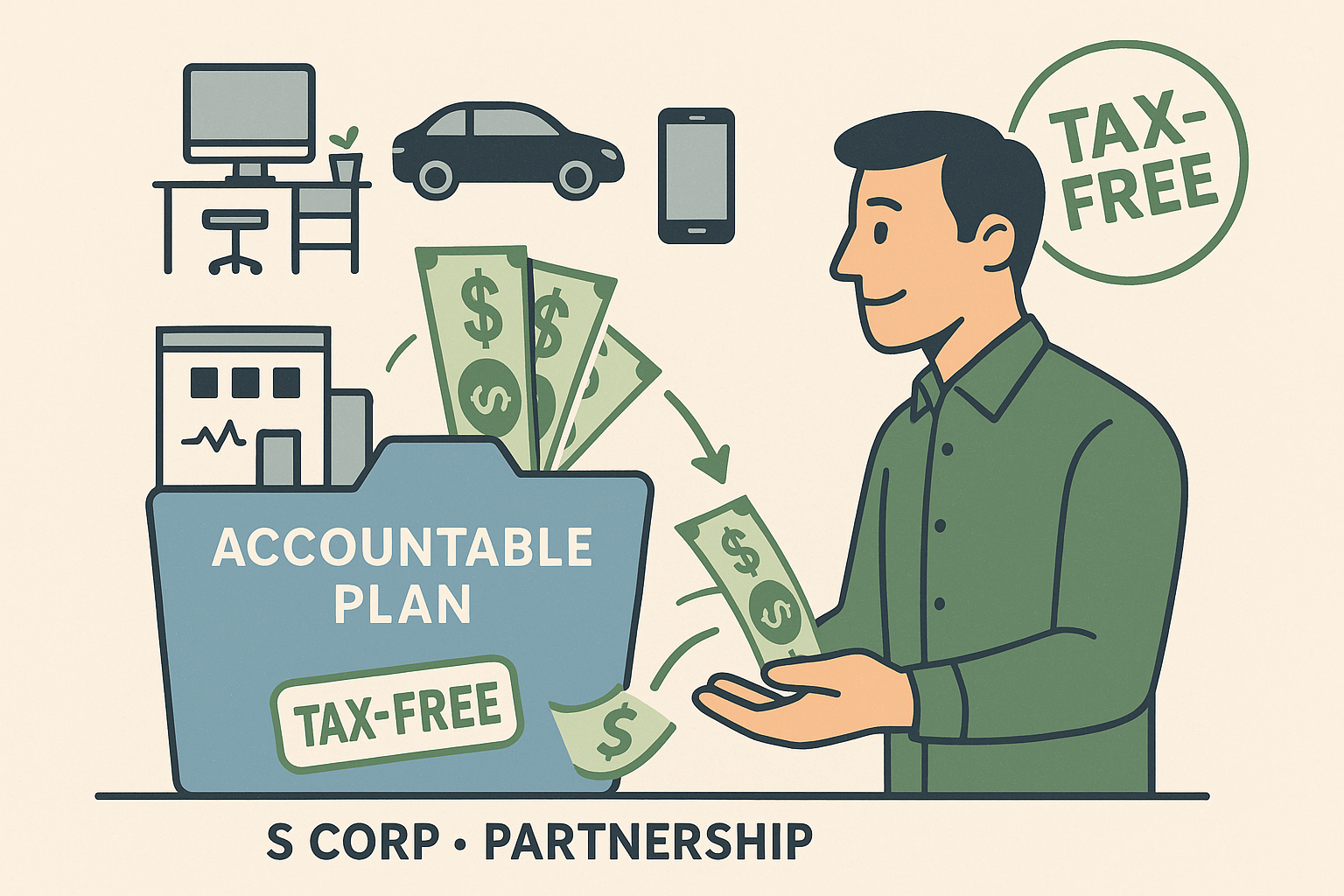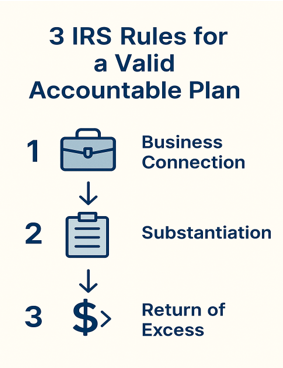
Introduction
Ever wondered how you can get reimbursed by your business for home office use, mileage, or your cell phone — without paying taxes on it? That’s where Accountable Plans come in.
According to the IRS, reimbursements under an accountable plan are not considered income. That means no payroll tax, no income tax — just more money in your pocket.
You might be thinking, “Wait… you’re telling me I can write myself a check for business expenses and not pay tax on it?” Yep. Totally legit— if you do it right. And if you’re an S Corp or partnership owner, not having one could be costing you thousands.
Whether you’re an S Corp owner trying to deduct your home office or a partner covering travel expenses, understanding how accountable plans work could save your business thousands each year. Let’s break down how they work, why they matter, and how to implement one the right way.
What Is an Accountable Plan?
At its core, an accountable plan is a reimbursement policy. It lets your business pay you (or employees) back for legitimate business expenses — without treating those payments as taxable income.
But here’s the catch: the IRS has rules. There are three big ones:
- The expense must have a business connection. Think ordinary and necessary to the operation of the business.
- You must substantiate it — receipts, mileage logs, etc.
- If the reimbursement exceeds the actual expense, the excess must be returned.
Miss any of those three, and you’re no longer in accountable plan territory — you’re in “non-accountable plan” land. And that can turn into a disaster.
So, who should care about this? Honestly, most business owners. But especially:
- S Corp shareholders/employees (because personal deductions are off the table)
- Partners in a partnership who pay for business stuff out of pocket
- Any business that wants to avoid payroll tax on reimbursements
Think of an accountable plan as your IRS-approved reimbursement shield. Use it right, and you keep more of your money, legally.
Why S Corps and Partnerships Need Accountable Plans

Here’s the frustrating truth: if you’re an S Corp owner or a partner in a firm, you’re probably paying for stuff out of pocket — and not getting any tax benefit.
Back in the day, you could deduct unreimbursed business expenses on Schedule A. But after the 2017 tax law changes? Nope. That whole deduction category was wiped out.
So let’s say you’re an S Corp owner and you’re paying for your internet, cell phone, home office, or mileage out of your own bank account. If the business doesn’t reimburse you under an accountable plan, that’s it — no deduction, no tax benefit.
We see this play out all the time. Suppose you drive around 12,000 miles a year for business and have a beautifully organized spreadsheet tracking your trips. The problem? If you never get reimbursed by the S Corp under an accountable plan, those deductions never exist. We can set up a mileage reimbursement policy mid-year, and boom — you save over $2,000 in taxes that year alone.
For partnerships, the rules are different but equally important. Partners can’t be treated as employees, which means they don’t get W-2s. But if the partnership doesn’t reimburse a partner for business expenses, then the only workaround is reducing the partner’s basis or capital account — a messy process, and not always practical.
The accountable plan fixes all this. With it:
- The business deducts the expense.
- You get reimbursed tax-free.
- Everyone wins.
Real-world savings? Easily thousands per year. Especially if you’ve got travel, a solid home office, or any kind of client-facing work.
Bottom line: if your business isn’t formally reimbursing you for business costs, you’re probably leaving money on the table. Or worse, you’re doing it wrong and risking an audit.
IRS Requirements for a Valid Accountable Plan
Now let’s talk about the rules. To qualify as an accountable plan, your reimbursement setup has to check all three of these boxes:

1. Business Connection
You must have incurred the expense as part of performing services for the business. That means it has to be legit — things like travel, internet, home office, office supplies. No mixing in your dog’s vet bill or your kid’s iPad.
2. Substantiation
This is the paper trail. Receipts, mileage logs, credit card statements, calendar notes — whatever backs up the claim. While you can sometimes use estimates under the Cohen rule, undocumented expenses nearly always get thrown out in an audit.
3. Return of Excess Payments
This one often trips people up when they are the sole business owner. If the business gives you more than what you actually spent (say, a $500 travel advance but only $400 in receipts), you have to return the difference. If you don’t, the whole thing could become taxable income.
Pro tip? Set a deadline for submitting expenses (usually 60 days) and returning excess funds (typically 120 days). It helps prove to the IRS that you’re following a real plan — not winging it.
Common Reimbursable Expenses Under an Accountable Plan

Here is the fun part–some expenses you can get reimbursed for in your business.
Home Office
For S Corp owners, this one is tricky. You can’t take the home office deduction personally. But your business can reimburse you for the actual cost of your home office if done through an accountable plan. I usually do a square footage method — calculate the percentage of your home used for business, then apply it to rent, utilities, internet, etc.
Mileage and Vehicle Use
Two options here: standard mileage or actual expenses. Most of my clients go with the standard mileage rate (updated yearly by the IRS). It’s easier, and you don’t have to track gas receipts or maintenance logs. Just the miles. Actual expenses tends to only be bigger with large vehicles completely dedicated to the business.
Internet and Cell Phone
If you’re using personal internet or phone service for work — and most of us are — you can get reimbursed based on percentage of use. Just don’t go crazy. The IRS is not going to believe you when you say you use 100 percent of your cell phone for business if you don’t have a separate personal line.
Travel and Lodging
Conferences, client meetings, hotel stays, flights, Uber rides — all good, as long as there’s a legit business reason. Keep a copy of the agenda or flight confirmation in your records.
Meals
Only 50% of meals are deductible (and reimbursable). The IRS rules here are strict. Meals must be tied to a business purpose. I always jot a quick note on the receipt: who I met with and what we talked about.
Office Supplies, Equipment, Software
Zoom subscriptions, ink, monitors, even a new desk — if it’s for work, it qualifies. Just track it. You can track this in QuickBooks Online or even just use a Google Sheet with columns for date, vendor, amount, and business purpose.
All of these should be reimbursed through the accountable plan — and not run through payroll or treated as owner draws.
How to Set Up an Accountable Plan in Your Business
Setting up an accountable plan might sound complicated, but it’s really not. You just need a little structure. Here’s the step-by-step:
1. Write a Policy
Put it in writing. It doesn’t have to be fancy — just clear. Include:
- What expenses are eligible
- How and when they must be submitted
- Required documentation
- Deadline for returning excess funds
2. Approve the Plan
If you’re a solo owner, you can adopt it yourself. If there are partners or a board, get formal approval and keep a signed copy on file.
3. Implement the Reimbursement Process
Use a tool — Expensify, QBO, Google Sheets, even a simple PDF template. Just make it easy to track, submit, and reimburse.
4. Book it Right
Reimbursements should be booked to the appropriate expense category, not payroll. And definitely not as owner draws.
5. Loop in Your Accountant
Seriously, don’t DIY the whole thing. A quick review can save you from a big mistake down the road. We’ve helped dozens of clients clean up past errors — and it always would’ve been cheaper to just do it right the first time. If you want to do this, just let us know and we can help you set it up.
5 Mistakes to Avoid with Accountable Plans
Here are the most common ones we see (and have lived through):
Mistake #1: Treating Reimbursements as Wages
If you pay yourself back for business expenses and run it through payroll? Boom. Now you’ve paid income tax, payroll tax, and possibly state tax. That’s a triple whammy.
Mistake #2: No Receipts or Logs
If it’s not documented, the IRS won’t believe it happened. Save and organize everything.
Mistake #3: Not Returning Excess
You give yourself a $500 travel advance but only spend $420? Return the $80. If you keep it, the IRS could say the entire $500 is taxable.
Mistake #4: Vague or Unwritten Plans
You need a policy. Something you can point to. “We kind of reimburse stuff sometimes” doesn’t cut it.
Mistake #5: Not Reviewing Annually
Mileage rates change. Your policies might need to change. Make it a habit to review your plan every January. It takes 15 minutes and keeps everything clean.
Conclusion
Accountable Plans aren’t just a tax loophole — they’re an essential tool for keeping your reimbursements tax-free and your business compliant. If you’re running an S Corp or a partnership and you’re still paying out-of-pocket for business expenses without a plan in place, it’s time to fix that.
It’s not hard. Write the plan, track your expenses, reimburse yourself, and keep the IRS happy. You’ll save money, stay compliant, and make your books cleaner in the process.
Ready to get started? Talk to your CPA (or reach out to us here at Elevated Tax and Accounting). We’ll help you draft a plan that works for your business and keeps more money in your pocket — where it belongs.
Disclaimer: This article is for informational purposes only and is not intended as tax, legal, or financial advice. Always consult with a qualified professional about your specific situation. Reading this post does not create a CPA–client relationship.

Joe Holbrook is a CPA and Partner at Elevated Tax & Accounting. Joe’s career has focused on helping business owners pay less tax and improve cash flow, serving companies ranging from small, local businesses, Fortune 500 companies, and everything in between. He also supports nonprofits fulfill their missions through financial excellence, given the highly active nonprofit environment surrounding Elevated’s office in beautiful Missoula, Montana.



